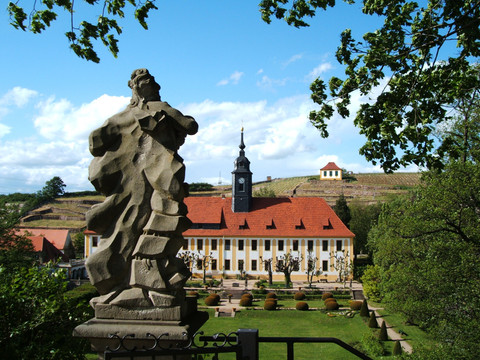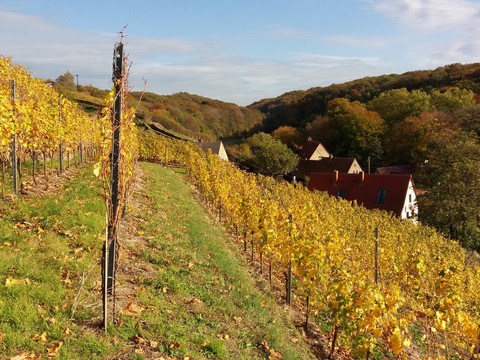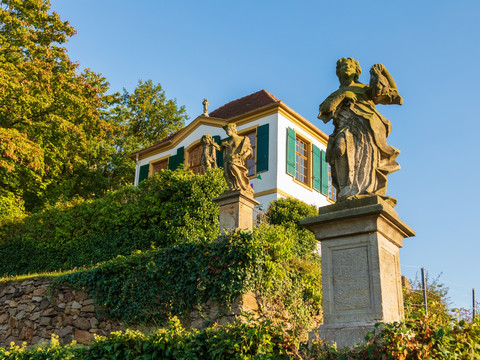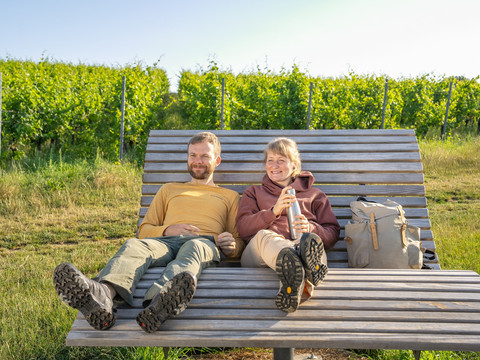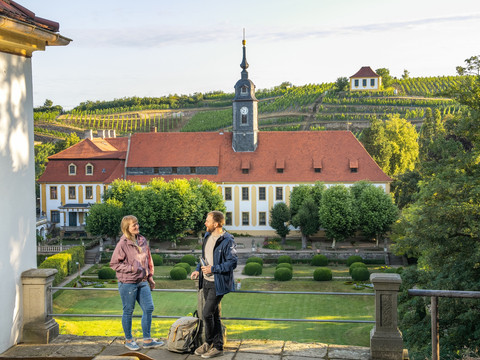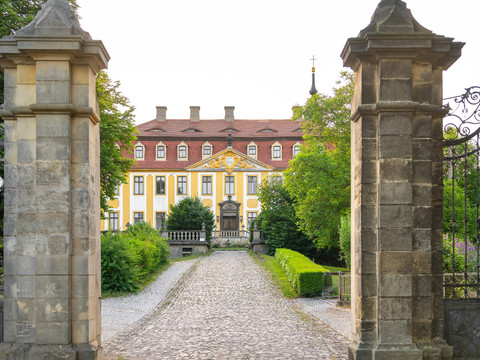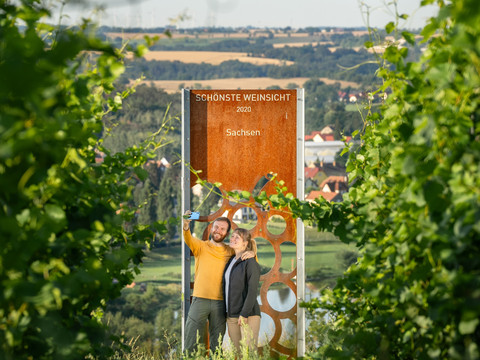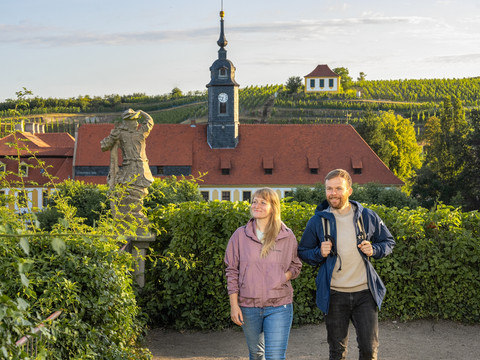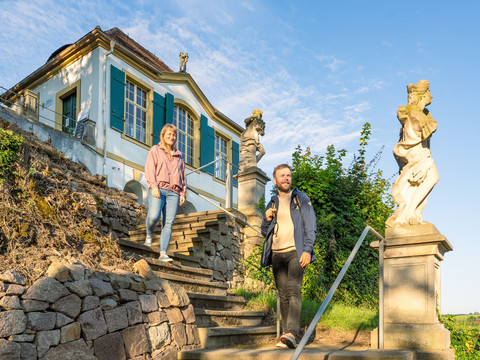From the station forecourt in Meißen we cross Großenhainer Street (pedestrian crossing) and turn into Ludwig-Richter Street, go uphill and then turn left into Ratsweinberg and circle the small vine slope clockwise. We reach Weinberggasse, turn left into it, cross Zscheilaer Street and follow Hafenstraße to Lindenplatz; from there, left to Fährgässchen and Dammweg (Elbe cycle path).
Downriver we go under the Elbe valley bridge, along the winter harbour to Hafenstraße, then briefly right and immediately left up the Katzenstufen (staircase) to the vineyards, which today are managed by Weingut Schloss Proschwitz Prinz zur Lippe.
Those who take the path left at the wrought iron gate (vineyard house and stele “Most Beautiful Wine View”) as a detour are rewarded on the Bennokanzel with an excellent view of the Meißen Elbe valley (approx. 20 mins walking).
After having cast our gaze through the stele “Most Beautiful Wine View 2016” at Albrechtsburg Meißen, we walk on Proschwitzer Street through the village– past the renovated Proschwitz Castle with its impressive and accessible park– up to a fork at the exit.
We turn left towards Winkwitz (Thomas-Müntzer Street). In Winkwitz we follow the trail marker, turn left into Schulstraße, then follow Winkwitzer Street on the left side through orchards and vineyards, past a playground, to Rottewitz (both former villages now belong to the town of Meißen). Turning left into Rottewitzer Street, at the end we take a small path right down into the valley.
We soon arrive at a coat of arms gate that enables us to enter the vineyards (please close the gate again to protect against wildlife damage). Heading right, we walk on a service road above the vineyards to a wider service road, then left to a vineyard gate. Now right on a fruit tree alley towards Diera, at an intersection turning left onto the paved road (Eisenacher Street) to Karpfenschänke (district of Diera-Zehren). At the entrance to Karpfenschänke we turn right off the road according to the trail marking and again pass through gates into the Lippe vineyards and finally, following the trail markers, to Zadel with the widely visible St. Andreas Church, which lies along the way (Kirchstraße).
We enter the cemetery and walk past the church to the lower cemetery entrance, where we meet Dorfanger Street. Over Dorfanger, right into Schulstraße, left into Hohlweg– past the district “Neumühle”– and Zum Forsthaus we see on the left the vine slopes of the Golk forest with the Winzerhof Golk (restaurant, guesthouse, vinotheque).
Past the “Talhaus Golk” (inn) we turn right off Zum Forsthaus Street after 200 m into a small forest path. On the Kirch(en)weg we pass through the Golk forest to Löbsal with a fork in the village centre (village square, inn Jägerheim). The right path at the fork leads us towards Burgberg, an important Bronze Age archaeological site.
Along the former school path we walk downhill through the forest to Diesbar, one of the wine villages which, with its traditional inns and steamboat traffic, have been excursion destinations for Meißen and Dresden residents since the late 19th century. Many vineyards and old vintners' houses shape the village, now also home to young wineries and modern eateries. We take another look downriver at the “Bösen Bruder”, a granite quarry closed in 1965, before climbing right uphill on Am Brummochsenloch past the Weingut Jan Ulrich.
On Radewitzer Street we reach the Goldkuppe (184 m), the largest Bronze Age fortification in Saxony (400 x 1100 m). Through an unlocked gate we pass large vineyard areas and the “Most Beautiful Wine View 2020” with a view over the Elbe in Diesbar-Seußlitz. The path through the vineyards along a steeply sloping cliff occasionally offers beautiful wide and deep views of the Elbe valley and the Göhrischfelsen on the opposite Elbe side. We pass a gate and reach after a few meters through the forest the viewing terrace of the Heinrichsburg, a garden house built in 1728 by the then castle owner Heinrich von Bünau following George Bähr’s plans.
From here we have a breathtaking view of Seußlitz Castle (not accessible) with its park (accessible), the adjacent George Bähr Church (open, worth seeing, as well as the historic cemetery), the opposite side Luisenburg (also built as a garden house), the Elbe ferry to Niederlommatzsch and Hirschstein Castle on the opposite side of the Elbe.
We descend some steps, past the sandstone figures by Permoser representing the 12 months, and reach the forest road. We walk a short stretch down the forest road. Now we can either enter the French park of Seußlitz Castle to the right and look around the grounds, or turn right onto An der Weinstraße Street and reach the 6th stage destination and end of the Saxon Wine Hiking Trail (car park below the castle with access to the ferry to Niederlommatzsch, bus stop Seußlitz, castle/ferry with return possibility to Meißen, various information boards, restaurant, café and guest house on the castle grounds).
Note: Parts of the path run along or through nature reserves. Leaving the paths is prohibited in these areas to protect flora and fauna. Please observe the signs.
